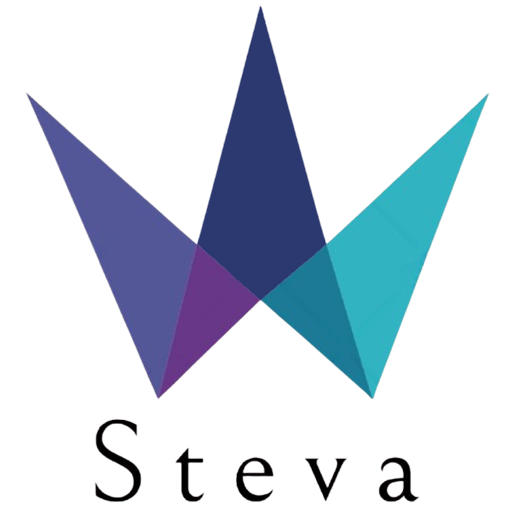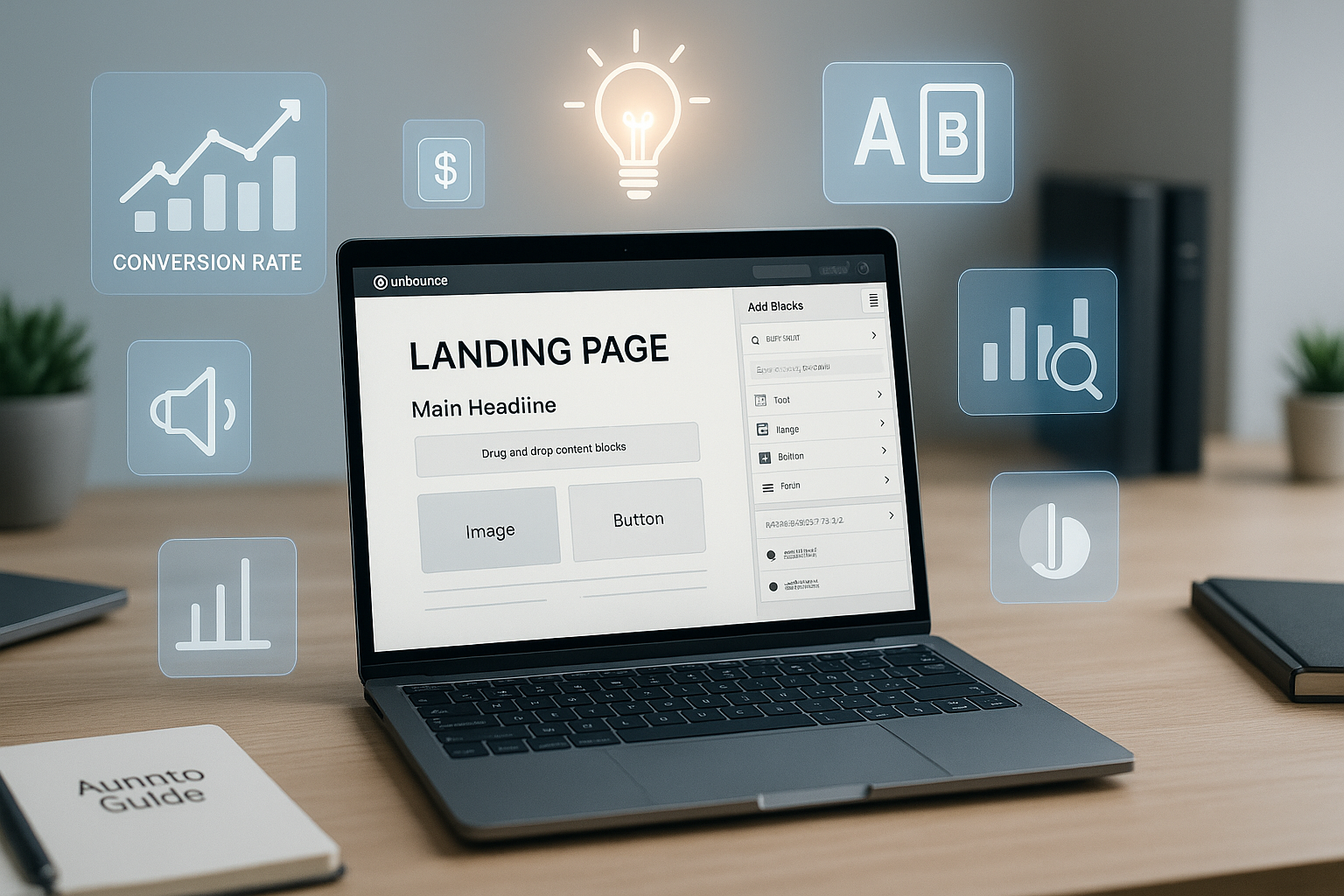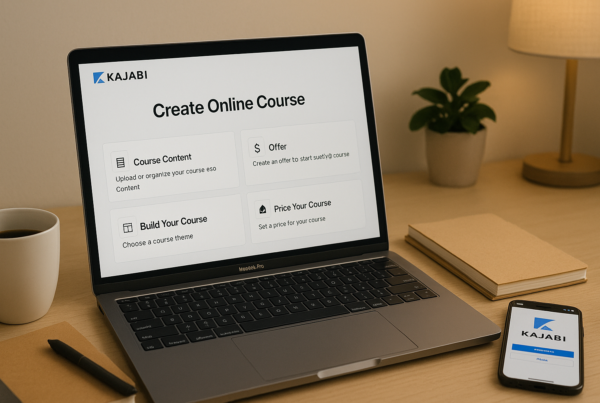Need an honest Unbounce review? The platform has helped generate over 1.5 billion conversions and serves 120,000 active customers as a top landing page builder. Your business needs high-converting landing pages, regardless of size, from startups to big names like New Balance. Unbounce takes a unique approach compared to competitors. While Instapage provides 200+ templates, Unbounce focuses on quality with 101% well-designed options and advanced AI features. The Smart Builder helps create pages quickly in under five minutes. This speed matters since 53% of visitors abandon pages that load slower than 3 seconds. The platform costs $90 monthly, which might make you wonder about its value. Let’s get into how Unbounce stacks up against alternatives and determine if it matches your business requirements.
What Is Unbounce and How Does It Work?
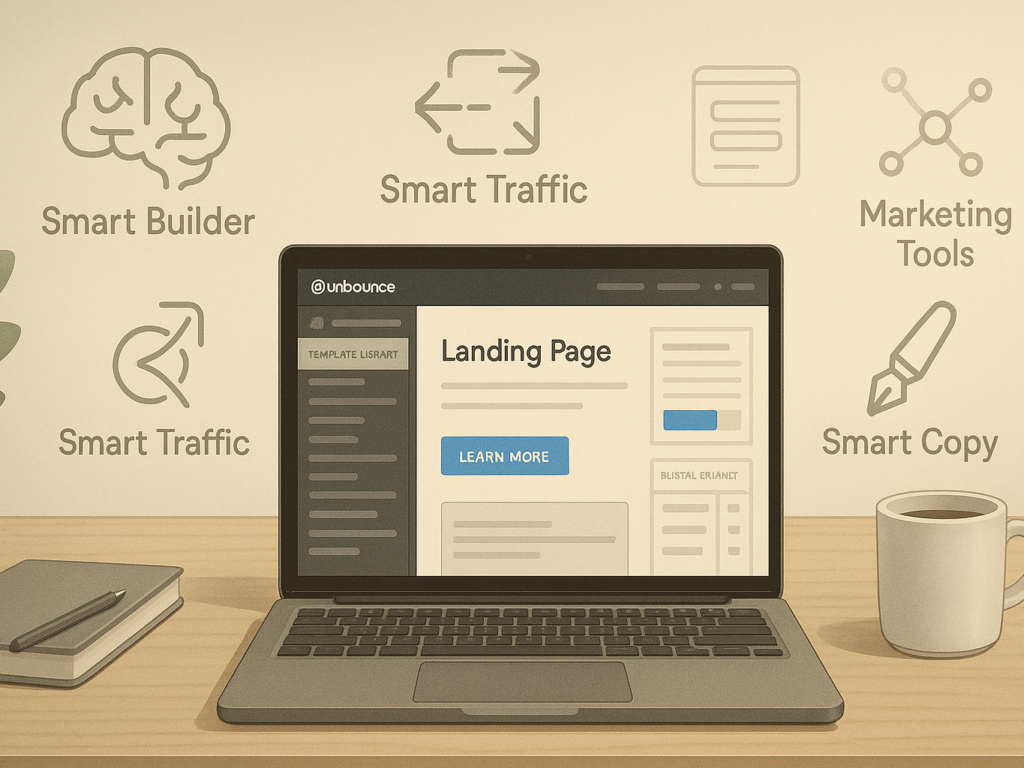
Unbounce is a leading Software as a Service (SaaS) platform that helps users create better marketing campaigns through landing pages, pop-ups, and sticky bars. The company started in 2009 and now has over 200 employees worldwide. Their platform has powered more than 1.5 billion conversions.
1. Key features of the Unbounce landing page builder
The heart of Unbounce is its resilient drag-and-drop landing page builder that makes creating conversion-focused pages available to everyone, regardless of their technical expertise. The platform has:
- Complete Template Library: Access to over 100 professionally designed, conversion-optimized templates for businesses of all types. These templates serve specific needs like lead generation, consultancy, webinars, events, and e-books.
- No-Code Building Experience: The drag-and-drop editor gives you full creative control without coding knowledge. You can customize every element down to the pixel level and add your brand elements without limits.
- A/B Testing Capabilities: You can create multiple versions of landing pages to test different elements and find which designs convert best. The platform lets you split traffic any way you want across page variants.
- Mobile Responsiveness: Pages adjust automatically for mobile devices. Your landing pages look great and work perfectly on all screen sizes.
The platform also offers customizable pop-ups and sticky bars that you can add to any website page within minutes. These attention-grabbing elements help capture leads and improve conversion rates through targeted offers.
The platform blends with over 1,000 marketing tools through direct connections and Zapier integrations. It allows smooth data flow between landing pages and popular marketing platforms like Salesforce, HubSpot, and Mailchimp.
2. The technology behind Unbounce’s conversion platform
Unbounce stands out with its AI-powered “Conversion Intelligence” platform that combines human marketing expertise with machine learning to boost conversion rates. This innovative approach has three core technologies:
- Smart Builder: An AI-powered landing page builder that gives data-backed suggestions based on conversion data from over 1.5 million landing pages. The system watches visitor behavior and suggests improvements in real time to boost page performance.
- Smart Traffic: This AI optimization tool guides visitors to landing page variants where they’re most likely to convert based on their traits. Unlike traditional A/B testing, Smart Traffic starts optimizing after just 50 visits and can increase conversions by an average of 30%.
- Smart Copy: This AI copywriting assistant uses GPT-3 technology to create human-like copy quickly. It creates content for ads, emails, landing pages, and over 40 other copy needs in six different languages.
Unbounce maintains strong security measures with SSL encryption on all landing pages and five global data centers for optimal speed and follows worldwide data privacy standards like GDPR and CCPA/CPRA.
The platform serves different user groups as well as solo marketers, agencies with multiple clients, e-commerce businesses, and lead generation companies. Agencies get special features to manage multiple clients from one account while keeping client data separate.
Unbounce Reviews: What Real Users Are Saying
These Unbounce reviews come from people who actually use the platform. The feedback paints a mixed picture of this popular landing page builder. We looked at hundreds of customer testimonials to spot the most common patterns of praise and criticism. It should help you decide if Unbounce fits your needs.
1. Positive feedback from G2 and Trustpilot
Users who love Unbounce point to several features that make the platform great for their marketing:
- User-friendly interface: Users praise the drag-and-drop builder that makes landing page creation available to people who don’t know coding. According to G2 reviews, “Unbounce is super intuitive; the drag-and-drop builder makes creating landing pages simple, even for those without coding experience.”
- Conversion optimization: Marketing teams love how Unbounce enables them to build and test different creative approaches without needing developers. A reviewer noted, “Unbounce allows us to build and test different creatives without the need for any developers. Our marketing team can manage 100% of the process”.
- Mobile responsiveness: The platform’s mobile optimization capabilities impress many users. Pages look great on devices of all sizes, from desktops to smartphones.
2. Common complaints and limitations
Unbounce has its share of drawbacks, as highlighted in many Unbounce reviews:
The recent pricing changes top the list of user complaints. Many reviewers talk about unexpected price hikes. One user saw their monthly cost jump “from USD 105.00 to USD 298.00“. An agency reported their fees went up “by 6x (reduced sessions + reduced domains),” making the service “unsustainable” for their business.
Support quality varies a lot. Some users waited “72 hours and counting” for help with their tickets. Others felt “gaslighted” when they tried to fix billing problems. The switch to AI chatbots for first-line support has made some users unhappy.
Technical issues often show up in negative reviews. Random formatting glitches, mobile display problems, and limited design options frustrate users. One reviewer said, “You spend hours creating something, only to save it and have the format change without you making any changes.”
3. Ease of use and learning curve assessment
Unbounce finds a sweet spot between being available and functional for mid-level marketers:
The platform welcomes beginners with a gentle learning curve. Most people get comfortable with the basics after a day of focused learning. One reviewer in Unbounce reviews says the drag-and-drop editor “works like a dream” and lets users work “totally without boundaries.”
Advanced features take more time to learn properly. The core tools feel natural to use, but some sophisticated functions have “a bit of a learning curve.” This extra effort pays off for marketers who create and test landing pages regularly.
The quality templates are a huge plus for users. Reviewers consistently call the pre-built templates “high-quality” and “genuinely usable.” These templates give users a great starting point for designing new pages.
Unbounce works best for marketers with some digital experience rather than complete beginners. One reviewer puts it well: “It’s fair to say that both Unbounce and Instapage have left [the glitchy, unstable] days well and truly behind. Unbounce is super stable and reliable. It is a real pleasure to use day-to-day.
Unbounce Pricing: Breaking Down the Cost Structure
Unbounce has updated its pricing structure in 2023. The platform now gives you three different tiers that match your business needs and conversion goals. You should think about these plans before making your investment decision.
1. Launch, Optimize, and Accelerate plan comparison.
The platform has three main pricing tiers, each with its own limits and features:
Launch Plan (formerly called Build): Priced at $99/month when billed monthly or $74/month when billed annually. This starter plan has the following:
- 500 conversions per month
- 20,000 unique visitors monthly
- 1 connected domain
- 2 user accounts
- Core features like Smart Builder, Unbounce Apps, and Copy Assistant
Optimize plan (formerly Experiment): Costs $149/month billed monthly or $112/month billed annually. This mid-tier plan gives you the following:
- 1,000 monthly conversions
- 30,000 unique visitors
- 5 connected domains
- Unlimited users
- Advanced features like A/B testing and Smart Traffic
Accelerate Plan: Priced at $249/month billed monthly or $187/month billed annually. This premium tier delivers:
- 2,500 monthly conversions
- 50,000 unique visitors
- 10 connected domains
- Advanced targeting capabilities
Businesses with enterprise-level needs can opt for the Concierge Plan. This custom solution starts at $499 per month and comes with tailored onboarding, team training, and migration support.
2. Monthly vs annual pricing differences
Annual billing saves you money compared to monthly payments.
The standard Unbounce pricing plans offer a 25% discount with an annual commitment. The Launch plan drops from $99 to $74 monthly when paid annually, saving you $300 over the year. The Optimize plan’s yearly discount gives you a total savings of $444, while the Accelerate plan offers the most significant savings, with $744 cut from your yearly cost.
Annual plans often come with special deals. You might save up to 35% on your first year through various affiliate partners.
Hidden costs to think over
The advertised pricing isn’t the whole story. Here are some extra costs you should factor in:
- Overage charges can add up fast if you go over your plan’s limits. Unbounce alerts you at 85% and 100% usage levels. You’ll need to upgrade your plan or pay a one-time fee for exceeding limits.
- Domain limitations might cost you more. Each plan caps the number of connected domains, starting with just one on the Launch plan. More domains mean upgrading your plan, and this affects agencies or businesses running multiple websites.
- Mid-cycle upgrades change your billing. Switching from monthly to annual billing means paying the full yearly fee right away, though Unbounce subtracts any unused amount from your current plan.
- Mandatory annual payment applies to certain plans. The Agency plan requires an upfront yearly payment of $5,988. It could strain your cash flow if you’re growing your agency.
Take advantage of Unbounce’s 14-day free trial. You’ll get full access to all features in your chosen plan with no limits. Helps you assess if the investment matches your needs.
Instapage vs Unbounce: Feature-by-Feature Comparison
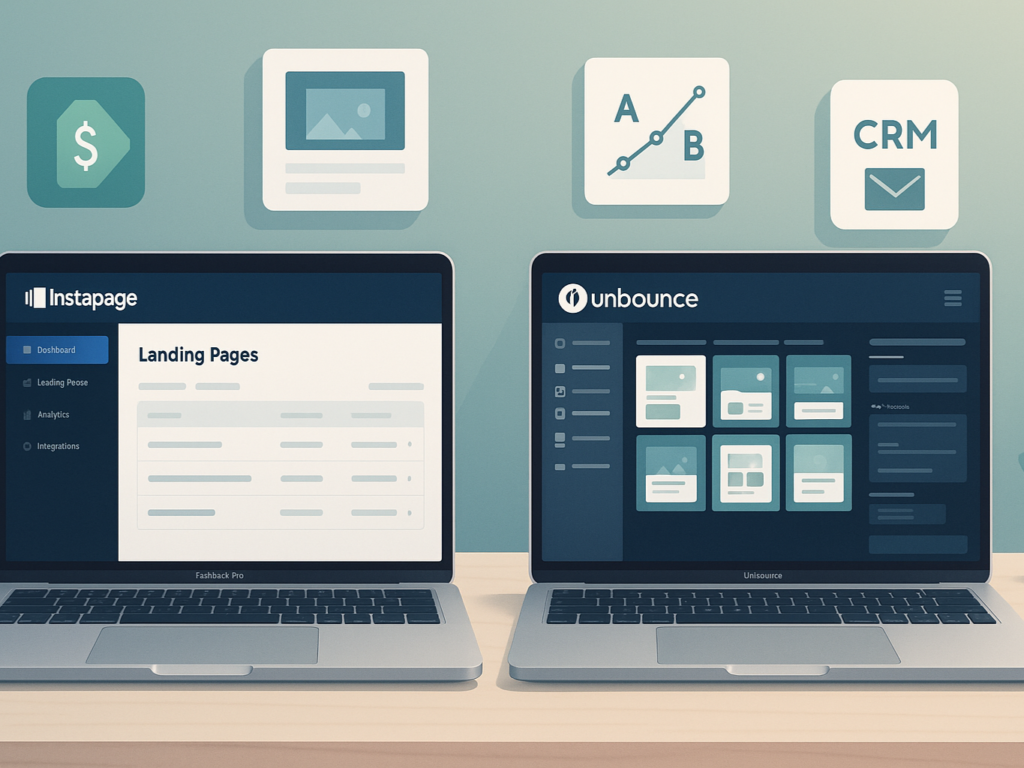
Reviews and expert analysis of landing page builders show key differences between Instapage and Unbounce. Let’s look at how these popular platforms match up for marketers who want the perfect conversion tool.
1. Pricing and value comparison
The price gap between these platforms is a major factor that can influence your decision, especially if you’re working within a budget and looking for the best value and features.
- Unbounce pricing starts at $99/month for the Launch plan (or $74/month billed annually). You’ll get 500 conversions, 20,000 visitors, and one domain. This makes it “the best bang for your buck for starter plans and companies with just a few landing pages.”
- Instapage starts at $199/month for their Business plan. You get unlimited conversions and domains, but at a much higher starting price.
Unbounce gives better original value to small businesses and startups. Instapage sees itself as a premium solution that can deliver better ROI for larger marketing teams. One analysis points out that “For companies where landing pages are already a big part of their marketing strategy… Instapage definitely wins with their Enterprise plan”.
2. Template quality and customization options
Both platforms offer professional templates, but in the Unbounce vs Instapage comparison, they differ in style, customization, and niche focus; one may suit creatives more. At the same time, the other is ideal for business or ecommerce use.
- Template quantity: Unbounce has about 100 templates. Instapage claims 500+ but actually has around 100 full landing page templates.
- Design quality: Instapage’s templates “feel more modern and professional.” Unbounce focuses on conversion optimization instead of quantity.
- Ecommerce options: Both platforms have a few e-commerce-specific templates. Unbounce has 3, while Instapage has 11.
Instapage leads in customization with precision design tools like “alignment and grouping features… the first of their kind”. These Figma-like features help build landing pages. The tools keep element proportions consistent on different screen sizes.
3. A/B testing capabilities
Each platform handles testing differently, with unique tools for A/B testing, analytics, and performance tracking, impacting how effectively you can optimize user experience and boost conversions.
- Unbounce has A/B testing in premium plans with its unique “Smart Traffic” feature. AI automatically sends visitors to page variants that are more likely to convert based on their traits.
- Instapage “has the better organization of ongoing tests and lets you enter your test hypothesis when creating a new test.”
Instapage gives data-driven marketers detailed testing tools. These include heatmaps that track mouse movements, scrolling patterns, and click maps. In the Unbounce vs Instapage comparison, Unbounce’s AI approach needs less setup but gives you less control over testing options.
4. Integration ecosystem differences
Both platforms connect to major marketing tools in their own way, offering integrations with CRMs, email platforms, and analytics, which are crucial for managing campaigns and tracking performance seamlessly.
- Unbounce connects with “Google Analytics, Salesforce, HubSpot, Mailchimp, Zapier, Google Tag Manager,” and many others. It works directly with dozens of popular platforms and “connects to over 5,000 apps without typing a single line of code” through Zapier.
- Instapage has “over 120 built-in integrations”. It focuses on quality over quantity and includes unique integrations like Zoho CRM, which Unbounce doesn’t have.
Both platforms support webhooks for custom integrations with specialized tools. Instapage comes with more native integrations, while Unbounce makes up for it with strong Zapier support.
Your choice between these landing page builders depends on what you need. Unbounce works better for smaller teams and beginners. Instapage shines with advanced design precision and testing features for marketing teams that rely heavily on landing page optimization.
Unbounce vs ClickFunnels: Which Converts Better?
The battle between Unbounce and ClickFunnels boils down to a basic difference in approach. Unbounce shines at creating standalone landing pages, while ClickFunnels gives you a complete sales funnel solution. This difference shapes how each platform handles conversions, and which might work better for your business needs.
1. Sales funnel capabilities comparison
Unbounce and ClickFunnels serve different purposes in the marketing ecosystem: Unbounce excels at building high-converting landing pages, while ClickFunnels focuses on creating complete sales funnels from start to finish.
- Unbounce focuses on single, high-converting landing pages that work best for specific campaigns. The platform excels at getting leads at the top of the funnel but needs third-party tools to handle downstream processes like email nurturing or multi-step sales.
- ClickFunnels presents an all-in-one sales funnel solution that helps potential customers move from first contact to sale. The platform has email marketing, membership sites, and payment processing capabilities built right in.
Your choice depends on your marketing strategy. Unbounce delivers better customization for PPC campaigns or social media ads. ClickFunnels gives you pre-built templates that work well for various stages of the sales process.
2. Ease of use for non-technical marketers
Each platform makes it easy for marketers who don’t code, though they take different paths: Unbounce offers precision design tools, while ClickFunnels guides users through pre-built funnel templates.
- Unbounce has a drag-and-drop builder that gives you precise control over page elements, fonts, and layouts. Its rich customization options offer exceptional design flexibility, though you might need more time to learn all the features.
- ClickFunnels keeps things simple with pre-designed funnel templates that match different campaign goals. The platform makes it easy to build complex funnels that connect landing pages with email autoresponders and payment processors.
Your choice between these platforms depends on what matters most to your workflow. Unbounce vs ClickFunnels isn’t just about tools; it’s about approach. Unbounce gives you full creative control, perfect for brands that need custom, conversion-focused pages. ClickFunnels, on the other hand, offers an all-in-one system designed for quick funnel deployment, ideal for those who want fast results without heavy customization.
3. ROI potential for different business types
Return on investment changes based on your business model: Unbounce suits lead-gen and agencies, while ClickFunnels delivers better ROI for product sales and complete marketing funnels.
- For PPC advertisers and campaign-focused marketers, Unbounce delivers better ROI through advanced A/B testing, dynamic text replacement, and conversion optimization tools. The platform works best for businesses that want to maximize conversion rates from paid traffic.
- For digital product sellers and businesses needing complete sales automation, ClickFunnels often gets better returns. Built-in payment processing, email automation, and upsell/downsell sequences can boost customer lifetime value substantially.
Small businesses with specific campaign needs might get better value from Unbounce’s focused approach. Entrepreneurs selling courses, memberships, or digital products typically achieve higher ROI with ClickFunnels’ complete sales ecosystem.
Top Unbounce Alternatives Worth Considering
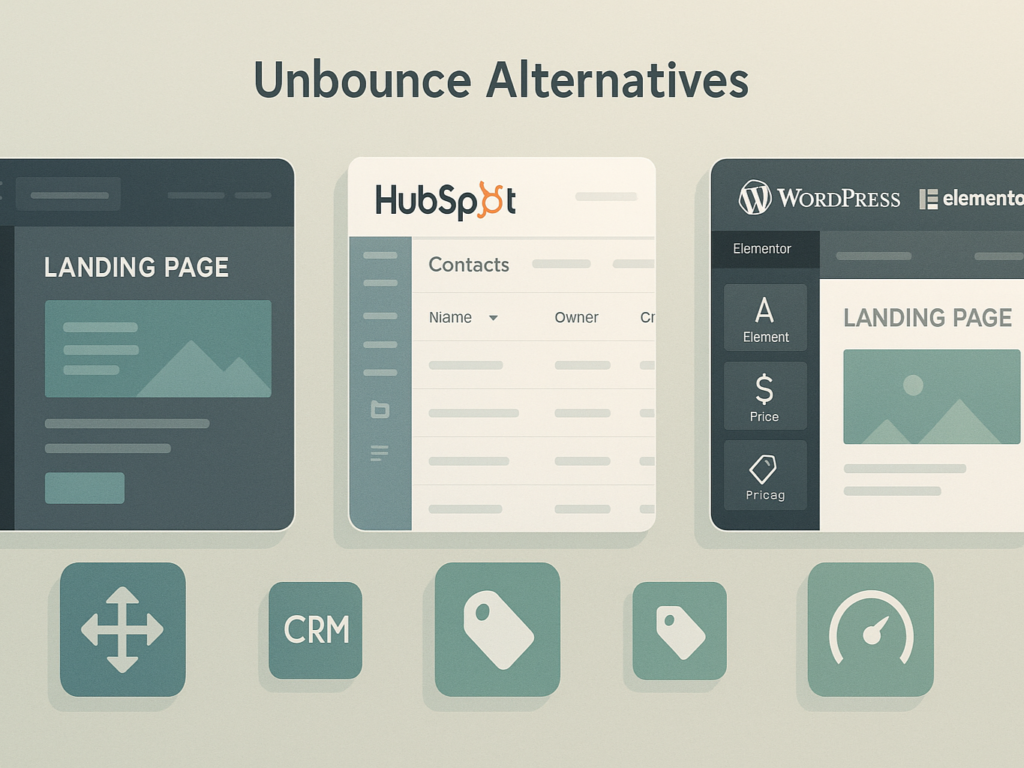
Learning about Unbounce reviews and competitors helps you find budget-friendly alternatives that match your needs. Let’s look at three excellent options that pack great features at reasonable prices.
1. Leadpages: The budget-friendly option
Leadpages excels as a budget-friendly Unbounce alternative built for lead generation. The platform costs $37/month with annual billing or $49/month paid monthly. This makes it much cheaper than Unbounce’s $99/month starting price.
Key advantages include:
- Over 200 conversion-optimized templates ready for customization
- Easy-to-use drag-and-drop editor that needs no technical skills
- Built-in conversion guidance through their “Lead Meter” feature
- Fast loading speeds that boost PPC ad quality scores
For small businesses and startups with tight marketing budgets, Unbounce alternative Leadpages provides essential features at a reasonable price, making it an excellent choice for cost-effective landing page creation and optimization.
2. HubSpot Landing Pages: For all-in-one marketing
HubSpot’s landing page builder is part of its comprehensive marketing ecosystem, making it an ideal Unbounce alternative for businesses that need more than just standalone pages and seek an all-in-one marketing solution.
The platform starts free (with HubSpot branding) and offers premium tiers:
- Starter plans begin at $20/month for basic features
- Professional tier ($890/month) adds advanced capabilities
- Enterprise solutions ($3,600/month) provide full features
HubSpot’s strength lies in its smooth integration with CRM and automation tools. This creates a unified experience throughout the customer’s path to purchase.
3. WordPress + Elementor: For website integration
WordPress users can make use of Elementor to build landing pages right within their existing website. This plugin offers:
- Precise drag-and-drop interface with extensive customization
- Global editing to keep consistency across pages
- Access to WordPress’s huge plugin ecosystem for added features
- Affordable pricing at $59/year for one site
This approach works best when you need landing pages that combine smoothly with your main website structure instead of standalone marketing assets.
Comparison Table
Feature | Unbounce | Instapage | ClickFunnels | Leadpages |
| Starting Price | $99/month ($74/month annually) | $199/month | Not mentioned | $37/month (annual) |
| Number of Templates | 100+ | 500+ (100 full landing pages) | Not mentioned | 200+ |
| Core Focus | Single landing pages with AI optimization | Advanced design precision | Complete sales funnel solution | Lead generation |
Key Features | • Smart Builder (AI-powered)• Smart Traffic• Smart Copy• A/B Testing | • Precision design tools• Advanced A/B testing• Heatmaps• Better test organization | • Complete funnel builder• Email marketing• Payment processing• Membership sites | • Lead Meter feature• Fast loading speeds• Drag-and-drop editor |
| Conversion Limit (Basic Plan) | 500/month | Unlimited | Not mentioned | Not mentioned |
| Visitor Limit (Basic Plan) | 20,000/month | Not mentioned | Not mentioned | Not mentioned |
Best For | • Small-medium businesses• PPC advertisers• Campaign-focused marketers | • Large marketing operations• Teams that need precise design control | • Digital product sellers• Sales automation needs | • Small businesses• Startups• Budget-conscious users |
| Integrations | 1,000+ via direct and Zapier | 120+ built-in | Not mentioned | Not mentioned |
| Mobile Responsiveness | Automatic adjustment | Yes | Not mentioned | Not mentioned |
| Learning Curve | Moderate | Advanced | Simple | Accessible |
Final Thoughts
Unbounce reviews often highlight how its AI features and intuitive design tools simplify landing page creation. Though the premium price may deter small businesses, Smart Builder, Smart Traffic, and Smart Copy offer real value.
The platform works best for:
- Digital marketers who need advanced A/B testing and want to optimize conversions
- Agencies that handle multiple client campaigns
- Mid-sized businesses looking to create professional landing pages
- Teams that want AI insights but still need creative control
Your choice between Unbounce and other options like Instapage or ClickFunnels comes down to what your business needs. Unbounce shines at building standalone, conversion-focused landing pages with its 100+ templates and reliable testing tools. This makes it a better choice for marketers who care more about landing page results than building complete funnels.
Unbounce gives you everything you need to create high-converting landing pages, whether you run targeted PPC campaigns or scale up your digital marketing. The platform balances powerful features with ease of use, making it a smart pick for businesses ready to step up their landing page game.
FAQs on Unbounce reviews
Q1. Is Unbounce worth the price?
Unbounce pricing reflects its powerful features, including AI tools, Smart Traffic, and advanced A/B testing. While it’s on the premium side, many marketers say the ROI justifies the cost, especially for conversion-focused businesses. If you’re a small team or startup, the cost may feel steep, but for seasoned marketers, the platform’s flexibility and performance-driven tools often make the price worthwhile.
Q2. Is there a free trial?
Yes, Unbounce offers a 14-day free trial with access to its core features. You can test its Smart Builder, templates, and A/B testing tools before committing to a plan. No credit card is required, making it a risk-free way to see if Unbounce fits your business needs. This trial helps users experience the interface and effectiveness of the platform without an upfront payment.
Q3. What is better: Unbounce or Instapage?
Unbounce vs. Instapage comes down to user needs. Unbounce offers more flexibility and is great for smaller teams or businesses looking for custom landing pages with AI support. Instapage, on the other hand, is geared toward large marketing teams that want granular control, collaboration tools, and heatmap testing. Both are top-tier, but your choice depends on budget, team size, and how much testing control you need.
Q4. Can I build sales funnels with Unbounce?
Unbounce isn’t built like ClickFunnels for multi-step funnels, but you can create sales funnel pages with connected landing pages and form tracking. With a bit of planning, Unbounce lets you map out conversion paths, test pages individually, and optimize each step. While it may require more setup, its flexibility makes it possible to build effective sales funnels tailored to your business goals.
